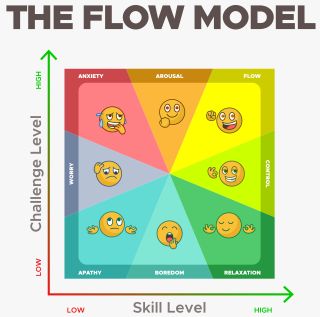Vagus Nerve
Does Vagus Nerve Activity Make Jogging More Enjoyable?
Cardio increases vagal activity, enhances blood flow, and makes running easier.
Posted October 1, 2023 Reviewed by Lybi Ma
Key points
- Cardio increases vagus nerve activity in ways that enhance coronary blood flow and make running seem easier.
- During exercise, the vagus nerve releases vasoactive intestinal peptide, improving fight-or-flight actions.
- Together, the vagus nerve's release of VIP and acetylcholine may promote flow states during cardio sessions.

This follow-up post is a personal perspective that filters the latest vagus nerve research on how exercise affects cardiac vagal nerve activity through my lived experience as a long-distance runner and someone who jogs daily.
Yesterday, I wrote a blog post, "Surprising Ways the Vagus Nerve Activates During Exercise," based on a new University of Auckland study (Shanks and colleagues, 2023) that found when sheep trot on a treadmill for 18 minutes, it increases cardiac vagal nerve activity in ways that cause the vagus nerve to release vasoactive intestinal peptide (VIP), which enhances coronary blood flow and makes each heart contraction more robust.
Coronary blood flow enhancements triggered by VIP improve the heart's cardiorespiratory capacity, making fight-or-flight activities like running easier.
Historically, increased vagus nerve activity has been associated with tranquility and rest-and-digest states of being. In 1921, a German-born researcher, Otto Loewi, discovered that the vagus nerve squirts out a calming, parasympathetic neurotransmitter called acetylcholine that slows heart rate and calms the nervous system. When Loewi first identified this calming substance being released by the vagus nerve, he called it "vagusstoff."
Does Jogging Activate the Parasympathetic and Sympathetic Nervous System Simultaneously?
The new (2023) discovery that cardiac vagal nerve activity increases during exercise in ways that promote better fight-or-flight physiology may shed light on the evolutionary roots of our unique ability to run long distances. When it comes to taking flight while running, humans are particularly well-equipped based on our body's design that allows us to spring through the air.
Beyond the biomechanics of running, I know as a long-distance runner that during aerobic exercise, something happens on a neurobiological level that promotes euphoric feelings of blissfulness associated with the runner's high.
I've always wondered why endurance running creates such a happy and serene state of mind when it's supposedly driven by the amped-up fight-or-flight responses associated with the sympathetic nervous system and decreased vagal activity. Based on my lived experience, the recent discovery that jogging on a treadmill for more than 15 minutes increases vagal activity and doesn't necessarily shut down vagus nerve functions makes sense.
Back in 2004, I broke a Guinness World Record by running six back-to-back marathons in 24 hours on a treadmill. Two decades later, I still do hour-long treadmill runs most days of the week. For me, the mindset associated with running is far removed from fight-or-flight freneticism. Jogging makes me feel energized and calm at the same time.
Acetylcholine (Vagusstoff) vs. Vasoactive Intestinal Peptide (VIP)

In a yin-yang way, acetylcholine and vasoactive intestinal peptide (VIP) may both be activated during moderate-intensity cardio sessions in ways that simultaneously engage the sympathetic and parasympathetic nervous systems. Having fight or flight and rest and digest mechanisms working in harmony may cultivate feelings of flow, which exist in a dynamic sweet spot between anxiety and relaxation.
Jogging on a treadmill doesn't feel as serene or exclusively rest and digest as doing diaphragmatic breathing exercises during a seated meditation (which hacks the vagus nerve and releases acetylcholine with every long exhale), but it also doesn't feel frantic like the fight or flight rush of sprinting to catch the bus so you're not late for work.
Does Increased Vagus Nerve During Cardio Activity Affect Flow States?
In addition to increased vagus nerve activity during exercise making cardio sessions feel easier, flow state experiences may also be influenced by increased vagal nerve activity. Based on personal experience, I know that the feeling of superfluidity and frictionless flow—which happens with unpredictable spontaneity when I'm running—feels like an instantaneous shift on both a psychological and neurophysiological level.
There's no way to know if changes in the amount of acetylcholine or VIP released by the vagus nerve at any given moment influence flow states. That said, the paradoxical nature of flow—which can simultaneously feel effervescent and energizing but also peaceful and grounding—suggests a push-pull within the autonomic nervous system that allows these seemingly opposite states of being to coexist.
Conclusion
The questions and hypotheticals raised in this personal perspective post about the role that increased vagus nerve activity during cardio may have on our state of mind while jogging is purely speculative. Hopefully, future evidence-based research will explore if the amount of acetylcholine and vasoactive intestinal peptide (VIP) released by the vagus nerve affects psychological states when people are doing cardio.
References
Julia Shanks, Mridula Pachen, Joshua W-H. Chang, Bindu George and Rohit Ramchandra. "Cardiac Vagal Nerve Activity Increases During Exercise to Enhance Coronary Blood Flow." Circulation Research (Published online ahead of print: August 29, 2023)




